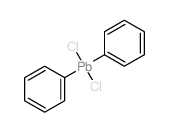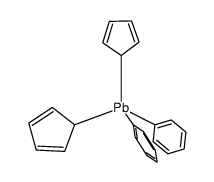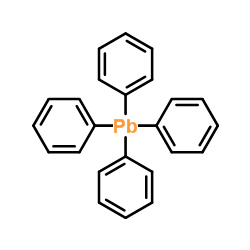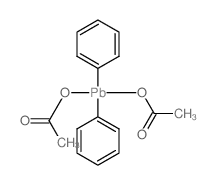2117-69-3
| 中文名 | 二苯基氯化铅 |
|---|---|
| 英文名 | dichloro(diphenyl)plumbane |
| 英文别名 |
Dichlorodiphenyllead
Lead,dichlorodiphenyl Diphenyldichloroplumbane Dichlorodiphenylplumbane EINECS 218-325-3 Plumbane,dichlorodiphenyl Diphenyllead dichloride |
| 沸点 | 362.3ºC at 760mmHg |
|---|---|
| 熔点 | 249-251ºC (dec.) |
| 分子式 | C12H10Cl2Pb |
| 分子量 | 432.31400 |
| 闪点 | 172.9ºC |
| 精确质量 | 431.99300 |
| LogP | 3.97180 |
| 蒸汽压 | 4.07E-05mmHg at 25°C |
| 计算化学 | 1.疏水参数计算参考值(XlogP):无 2.氢键供体数量:0 3.氢键受体数量:0 4.可旋转化学键数量:2 5.互变异构体数量:无 6.拓扑分子极性表面积:0 7.重原子数量:15 8.表面电荷:0 9.复杂度:174 10.同位素原子数量:0 11.确定原子立构中心数量:0 12.不确定原子立构中心数量:0 13.确定化学键立构中心数量:0 14.不确定化学键立构中心数量:0 15.共价键单元数量:1 |
|
Section1. IDENTIFICATION OF THE SUBSTANCE/MIXTURE Product identifiers Product name: DICHLORODIPHENYLLEAD CAS-No.: 2117-69-3 Relevant identified uses of the substance or mixture and uses advised against Identified uses: Laboratory chemicals, Manufacture of substances Section2. HAZARDS IDENTIFICATION Classification of the substance or mixture Classification according to Regulation (EC) No 1272/2008 [EU-GHS/CLP] Reproductive toxicity (Category 1A) Acute toxicity, Inhalation (Category 4) Acute toxicity, Oral (Category 4) Specific target organ toxicity - repeated exposure (Category 2) Acute aquatic toxicity (Category 1) Chronic aquatic toxicity (Category 1) Classification according to EU Directives 67/548/EEC or 1999/45/EC May cause harm to the unborn child. Possible risk of impaired fertility. Harmful by inhalation and if swallowed. Danger of cumulative effects. Very toxic to aquatic organisms, may cause long-term adverse effects in the aquatic environment. Label elements Labelling according Regulation (EC) No 1272/2008 [CLP] Pictogram Signal wordDanger Hazard statement(s) H302Harmful if swallowed. H332Harmful if inhaled. H360DfMay damage the unborn child. Suspected of damaging fertility. H373May cause damage to organs through prolonged or repeated exposure. H410Very toxic to aquatic life with long lasting effects. Precautionary statement(s) P201Obtain special instructions before use. P273Avoid release to the environment. P308 + P313IF exposed or concerned: Get medical advice/ attention. P501Dispose of contents/ container to an approved waste disposal plant. Supplemental Hazardnone Statements Restricted to professional users. According to European Directive 67/548/EEC as amended. Hazard symbol(s) R-phrase(s) R61May cause harm to the unborn child. R20/22Also harmful by inhalation and if swallowed. R33Danger of cumulative effects. R50/53Very toxic to aquatic organisms, may cause long-term adverse effects in the aquatic environment. R62Possible risk of impaired fertility. S-phrase(s) S53Avoid exposure - obtain special instructions before use. S45In case of accident or if you feel unwell, seek medical advice immediately (show the label where possible). S60This material and its container must be disposed of as hazardous waste. S61Avoid release to the environment. Refer to special instructions/ Safety data sheets. Restricted to professional users. Other hazards - none Section3. COMPOSITION/INFORMATION ON INGREDIENTS Substances Formula: C12H10Cl2Pb Molecular Weight: 432,31 g/mol ComponentConcentration DICHLORODIPHENYLLEAD CAS-No.2117-69-3- Index-No.082-001-00-6 Section4. FIRST AID MEASURES Description of first aid measures General advice Consult a physician. Show this safety data sheet to the doctor in attendance. If inhaled If breathed in, move person into fresh air. If not breathing, give artificial respiration. Consult a physician. In case of skin contact Wash off with soap and plenty of water. Consult a physician. In case of eye contact Flush eyes with water as a precaution. If swallowed Never give anything by mouth to an unconscious person. Rinse mouth with water. Consult a physician. Most important symptoms and effects, both acute and delayed To the best of our knowledge, the chemical, physical, and toxicological properties have not been thoroughly investigated. Indication of any immediate medical attention and special treatment needed no data available Section5. FIREFIGHTING MEASURES Extinguishing media Suitable extinguishing media Use water spray, alcohol-resistant foam, dry chemical or carbon dioxide. Special hazards arising from the substance or mixture Carbon oxides, Hydrogen chloride gas, Lead oxides Advice for firefighters Wear self contained breathing apparatus for fire fighting if necessary. Further information no data available Section6. ACCIDENTAL RELEASE MEASURES Personal precautions, protective equipment and emergency procedures Use personal protective equipment. Avoid dust formation. Avoid breathing vapors, mist or gas. Ensure adequate ventilation. Evacuate personnel to safe areas. Avoid breathing dust. Environmental precautions Prevent further leakage or spillage if safe to do so. Do not let product enter drains. Methods and materials for containment and cleaning up Pick up and arrange disposal without creating dust. Sweep up and shovel. Keep in suitable, closed containers for disposal. Reference to other sections For disposal see section 13. Section7. HANDLING AND STORAGE Precautions for safe handling Avoid contact with skin and eyes. Avoid formation of dust and aerosols.Avoid exposure - obtain special instructions before use. Provide appropriate exhaust ventilation at places where dust is formed. Conditions for safe storage, including any incompatibilities Store in cool place. Keep container tightly closed in a dry and well-ventilated place. Specific end uses no data available Section8. EXPOSURE CONTROLS/PERSONAL PROTECTION Control parameters Components with workplace control parameters Exposure controls Appropriate engineering controls Handle in accordance with good industrial hygiene and safety practice. Wash hands before breaks and at the end of workday. Personal protective equipment Eye/face protection Safety glasses with side-shields conforming to EN166 Use equipment for eye protection tested and approved under appropriate government standards such as NIOSH (US) or EN 166(EU). Skin protection Handle with gloves. Gloves must be inspected prior to use. Use proper glove removal technique (without touching glove's outer surface) to avoid skin contact with this product. Dispose of contaminated gloves after use in accordance with applicable laws and good laboratory practices. Wash and dry hands. The selected protective gloves have to satisfy the specifications of EU Directive 89/686/EEC and the standard EN 374 derived from it. Body Protection Complete suit protecting against chemicals, The type of protective equipment must be selected according to the concentration and amount of the dangerous substance at the specific workplace. Respiratory protection Where risk assessment shows air-purifying respirators are appropriate use a full-face particle respirator type N100 (US) or type P3 (EN 143) respirator cartridges as a backup to engineering controls. If the respirator is the sole means of protection, use a full-face supplied air respirator. Use respirators and components tested and approved under appropriate government standards such as NIOSH (US) or CEN (EU). Section9. PHYSICAL AND CHEMICAL PROPERTIES Information on basic physical and chemical properties a) AppearanceForm: solid b) Odourno data available c) Odour Thresholdno data available d) pHno data available e) Melting point/freezingno data available point f) Initial boiling point and no data available boiling range g) Flash pointno data available h) Evaporation rateno data available i) Flammability (solid, gas) no data available j) Upper/lowerno data available flammability or explosive limits k) Vapour pressureno data available l) Vapour densityno data available m) Relative densityno data available n) Water solubilityno data available o) Partition coefficient: n- no data available octanol/water p) Autoignitionno data available temperature q) Decompositionno data available temperature r) Viscosityno data available s) Explosive propertiesno data available t) Oxidizing propertiesno data available Other safety information no data available Section10. STABILITY AND REACTIVITY Reactivity no data available Chemical stability no data available Possibility of hazardous reactions no data available Conditions to avoid no data available Incompatible materials Strong oxidizing agents Hazardous decomposition products Section11. TOXICOLOGICAL INFORMATION Information on toxicological effects Acute toxicity no data available Inhalation: no data available Skin corrosion/irritation no data available Serious eye damage/eye irritation no data available Respiratory or skin sensitization no data available Germ cell mutagenicity Carcinogenicity IARC:No component of this product present at levels greater than or equal to 0.1% is identified as probable, possible or confirmed human carcinogen by IARC. Reproductive toxicity Presumed human reproductive toxicant Specific target organ toxicity - single exposure no data available Specific target organ toxicity - repeated exposure May cause damage to organs through prolonged or repeated exposure. Aspiration hazard no data available Potential health effects InhalationHarmful if inhaled. May cause respiratory tract irritation. Ingestion Harmful if swallowed. SkinHarmful if absorbed through skin. May cause skin irritation. EyesMay cause eye irritation. Signs and Symptoms of Exposure To the best of our knowledge, the chemical, physical, and toxicological properties have not been thoroughly investigated. Additional Information RTECS: TP4501000 Section12. ECOLOGICAL INFORMATION Toxicity no data available Persistence and degradability BiodegradabilityResult: - According to the results of tests of biodegradability this product is not readily biodegradable. Remarks: no data available Bioaccumulative potential no data available Mobility in soil no data available Results of PBT and vPvB assessment no data available Other adverse effects no data available Section13. DISPOSAL CONSIDERATIONS Waste treatment methods Product Offer surplus and non-recyclable solutions to a licensed disposal company. Dissolve or mix the material with a combustible solvent and burn in a chemical incinerator equipped with an afterburner and scrubber. Contaminated packaging Dispose of as unused product. Section14. TRANSPORT INFORMATION UN number ADR/RID: 2811IMDG: 2811IATA: 2811 UN proper shipping name ADR/RID: TOXIC SOLID, ORGANIC, N.O.S. (DICHLORODIPHENYLLEAD) IMDG: TOXIC SOLID, ORGANIC, N.O.S. (DICHLORODIPHENYLLEAD) IATA:Toxic solid, organic, n.o.s. (DICHLORODIPHENYLLEAD) Transport hazard class(es) ADR/RID: 6.1IMDG: 6.1IATA: 6.1 Packaging group ADR/RID: IIIIMDG: IIIIATA: III Environmental hazards ADR/RID: noIMDG Marine pollutant: noIATA: no Special precautions for user no data available SECTION 15 - REGULATORY INFORMATION N/A SECTION 16 - ADDITIONAL INFORMATION N/A |
CHEMICAL IDENTIFICATION
HEALTH HAZARD DATAACUTE TOXICITY DATA
|
| 风险声明 (欧洲) | 20/22-33-50/53-61 |
|---|---|
| 安全声明 (欧洲) | 45-53 |
| 危险品运输编码 | UN 2291 |
| 海关编码 | 2931900090 |
|
~% 
2117-69-3 |
| 文献:Gaffney, Christine; Harrison, Philip G. Journal of the Chemical Society, Dalton Transactions: Inorganic Chemistry (1972-1999), 1982 , p. 1055 - 1060 |
|
~% 
2117-69-3 |
| 文献:Herzog, Uwe; Rheinwald, Gerd Journal of Organometalic Chemistry, 2002 , vol. 648, # 1-2 p. 220 - 225 |
|
~% 
2117-69-3
详细
|
| 文献:Raj, Prem; Saxena, A. K.; Singhal, Kiran; Ranjan, Ashok Polyhedron, 1985 , vol. 4, p. 251 - 258 |
| 上游产品 5 | |
|---|---|
| 下游产品 3 | |
| 海关编码 | 2931900090 |
|---|---|
| 中文概述 | 2931900090. 其他有机-无机化合物. 增值税率:17.0%. 退税率:13.0%. 监管条件:AB(入境货物通关单,出境货物通关单). 最惠国关税:6.5%. 普通关税:30.0% |
| Summary | 2931900090. other organo-inorganic compounds. VAT:17.0%. Tax rebate rate:13.0%. Supervision conditions:AB(certificate of inspection for goods inward,certificate of inspection for goods outward). MFN tariff:6.5%. General tariff:30.0% |








